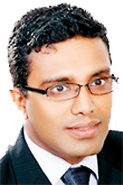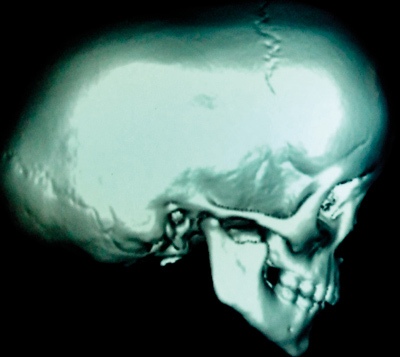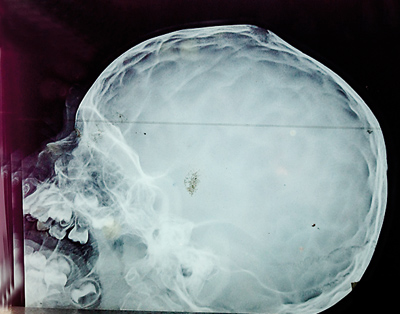Giving shape to a young life
Shapes are his specialty, especially the shapes of the head. This is the specialty, unavailable in Sri Lanka until this year (2013), which has paved the way for a two-year-old boy and many other children from becoming intellectually disabled and being relegated to a life marred by challenges.

Dr. Gayan Ekanayake
The head of this little boy was squashed in front and his growing brain was being entrapped by his skull, said Consultant Plastic Surgeon Dr. Gayan Ekanayake, 39. This Specialist whose forte is cranio-facial surgery who shuttles between the National Hospital in Colombo and the Karapitiya Teaching Hospital in Galle, brings hope to children and parents who have so far had no one to turn to.
The boy’s brain was making a valiant effort to push through and was putting so much pressure on the bones of the head that an X-ray revealed a “copper-beaten skull”, pointed out Dr. Ekanayake, explaining that it looked like a sheet of copper which had undergone a beating, leaving bumps and dents.
The cause was craniosynostosis which is the fusion of the skull bones (sutures) prematurely, while the baby is still in the mother’s womb, resulting in the head taking on an abnormal shape, MediScene learns.
The answer is to perform surgery on the child before he passes two years old, points out Dr. Ekanayake, reiterating that the avoidable repercussions would be disastrous. “The current thinking is that if surgery is delayed, the brain may sustain certain serious drawbacks when the child grows older,” he adds.
For a couple from Mount Lavinia, seeing their little girl soon after birth in October 2012 sent them into shocked disbelief.
Diagnosed with Apert Syndrome in which certain skull bones get fused prematurely, she had a sunken appearance in the middle of the face, bulging wide-set eyes, a misshapen head, a hole in her heart as well as her upper palate (cleft palate) and her toes and fingers were webbed, says her father recalling the heartbreak that they underwent on seeing her.The hospital rounds began then and it was NHSL’s Consultant Neurosurgeon, Dr. Himashi Kularatne, who referred them to Dr. Ekanayake.
After many surgeries, including the head surgery, the father says his little daughter “den lassanata innawa” (she is pretty now). Earlier she couldn’t look at the sun, but now she can. Before the operation she used to sleep with her eyes open, but no more.
We are very happy, he says, explaining that she will be able to lead a normal life as in addition to Dr. Ekanayake’s surgery, Consultant Plastic Surgeon Dr. Thushan Beneragama had also sorted out the pasted toes and fingers.

An abnormally long head
Now we are awaiting the palate surgery, he says with hope. Lamenting that the prevalence of craniosynostosis in Sri Lanka is not known, as no studies have been conducted here, Dr. Ekanayake says that while the causes include a genetic pre-disposition, in a vast majority of cases the reason is unknown.
The aim of the surgery in such fusion of the skull bones is to give a normal shape to the baby’s head, thus relieving the constriction of the brain, it is learnt. With the surgery involving “designing a new head from what is already existing” by making use of absorbable plates, Dr. Ekanayake underscores the fact that this operation needs a multidisciplinary team, comprising Neurosurgeons, Craniofacial Surgeons, Neuroanaesthetists and efficient nursing staff.
The Neurosurgeons take off the skull bones according to the design and the Craniofacial Surgeon moves the facial skeleton, the bones around the eyes, forward. This helps to correct the positions of the eyes, while bringing forward the face and forehead, is the simple explanation given by Dr. Ekanayake about this “complex and complicated” surgery.
He pays tribute to NHSL’s Consultant Plastic Surgeon Dr. Dulip Perera; Consultant Neurosurgeons Dr. Jayantha Liyanage, Dr. Himashi Kularatne and Dr. Saman Wadanambi; and Neuroanaesthetists Dr. Shirani Hapuarachchi, Dr. Rohini Ranwala, Dr. Manjula Kularatne and Dr. Bandula Pethangoda, while also commending the work of his juniors, nursing staff, ICU staff and staff in Wards 12 and 4 who provide excellent post-operative care to the patients.
Usually no surgery is performed for abnormal head shapes, but surgery would have to be offered, after careful examination, if fusion is causing pressure on the brain of babies who get craniosynostosis in the womb, according to Dr. Ekanayake.
It was while he was a junior at the Lady Ridgeway Hospital for Children in Colombo that he saw many children with abnormal head shapes whose parents didn’t know what to do.
Failed attempts, even though they were efforts to do some service, ended with the child having a funny-looking head, he says, recalling how this sparked his interest in craniofacial surgery.
Having been trained in this field at the world’s best centre, the Royal Children’s Hospital in Melbourne — which had successfully separated twins conjoined in the head in 2008 – he says his gurus there are icons, for those twins are alive.
Now with everything he is performing in Sri Lanka being new, Dr. Ekanayake is making a concerted effort to establish this specialty in this country.

Copper-beaten skull where there is severe pressure on skull bones
“Any child with an abnormal head shape gets the best standard care the world has to offer right here in Sri Lanka,” he assures, explaining that for this type of surgery there should be rigorous training, after which it becomes routine and “safer and safer with time”.
While hoping to get two more Craniofacial Surgeons trained in the next 10 years to make it sustainable, Dr. Ekanayake points out that starting very young, the children who undergo this type of surgery will be with him for 20 years. “It’s a lifelong commitment and I’m prepared to give that because I love treating kids.”
Whenever there is a “difficult” case, this Craniofacial Surgeon discusses it with a network of top surgeons including several in New Zealand and Australia. “I know what to do, but it is good to discuss subtleties with more experienced people. No one thinks alike and ‘out of the box’ thinking may sometimes provide better answers for unusual conditions,” he adds.
With surgery lasting about three to four hours, depending on the case, the level of care offered for facial trauma such as soft tissue injuries and fractures in Sri Lanka are on par with Australia, according to him.
All the equipment and services needed for these surgeries are available in Sri Lanka, MediScene learns, and patients may be referred through the Plastic Surgery Units of the NHSL, the Colombo North (Ragama) Teaching Hospital, the Colombo South (Kalubowila) Teaching Hospital and the Karapitiya Teaching Hospital.
A challenge is the cost of material in the form of absorbable plates, says Dr. Ekanayake, adding that if non-absorbable plates are used they can migrate into the brain and would have to be removed as the child grows up.
He requests donors to come forward to help these children get back the shapes of their heads.



